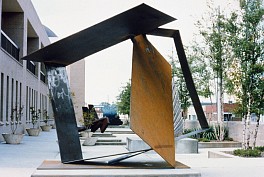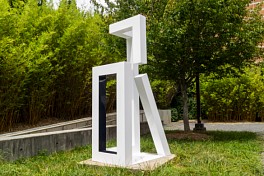Jane Manus Installation at the Bristol, Palm Beach
August 5, 2019
SPONDER GALLERY is pleased to announce the installation of a monumental sculpture by Jane Manus at The Bristol, Palm Beach’s most expensive luxury condominium. The namesake work stands 23 feet tall, and weighs over 1,000 lbs.
Jane Manus has been continuously developing her oeuvre of forceful geometric sculptures since the 1970s, when as a young artist at the Art Institute of Boston she learned to weld metal into sculpture, an experience Manus describes as a breakthrough in her artistic career. Manus’ work has indeed evolved, and today she works exclusively in aluminum. Her vibrant sculptures seamlessly integrate disparate elements of geometry, thereby truly transforming the spaces that they inhabit. Dynamic shapes and massive forms penetrate the viewer’s space, and seem to move and change in appearance due to their extreme three-dimensionality. Abstract though they are, Manus’ sculptures also retain an unyielding expressive character that gives each work a life and spirit of its own. Jane Manus was born in New York in 1951, and is based in West Palm Beach, Florida. Her work is found in many important collections, including The Harn Museum of Art, Gainesville, FL; The Lincoln Center/List Collection, New York; the Georgia Museum of Art; Syracuse University; Herbert F Johnson Museum at Cornell University, NY; Cornell Museum of Art, Winter Park, FL.
The Bristol is a 610,000 square-foot luxury condominium in the heart of West Palm Beach, Florida. The 25-story building is located on the Intracoastal Waterway overlooking Palm Beach Island, and includes 67 units, 12 guest suites, two parking levels, and several amenity areas. Units range from $7 to $14 million, although prices have gone higher for penthouse levels. Construction began three years ago on the site of the former Chapel-by-the-Lake.
Read More >>










